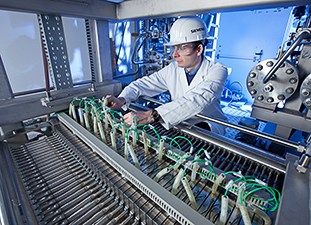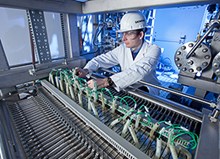A secure and hygienic environment needs to be maintained and monitored; virtual simulation through AR and VR can be used in drug analysis and development; in addition, the validation of products requires accuracy, consistency and transparency. Consistency of quality and production is vital and can be assisted by modelling and robotics.
The pharmaceutical industry and Industry 4.0 fit together hand in glove. This, understandably, quality critical and highly regulated industry benefits from being paperless and digitally integrated with a minimum of direct human contact with the products as compliance with Strict regulatory requirements is crucial.
“Classically, data is being obtained and stored on paper where established rules apply,” says Alwyn Jones, Head of Pharmaceutical & Life Sciences - UK & Ireland, at Siemens. “However, with a growing use of electronic systems for batch and process records, GMP-relevant data are often purely digital and require a different approach to ensuring data integrity. Companies often struggle with implementing suitable measures, as is demonstrated by a rise in FDA warning letters and EMA noncompliance reports in recent years. In addition to being, a legal requirement, data integrity is vital because if any data are incorrect or inconsistent they can jeopardize product quality and the safety of patients. The transition of data from paper-based to digital systems has also required new rules and technology to ensure data integrity and to counter threats such as human input errors, missing raw data, uncontrolled alterations without audit trails, invalidated data entries, and inadequate archiving.”
Jones points out that the UK’s Medicines and Healthcare Products Regulatory Agency (MHRA) issued a guidance document, In March 2015, on how to design systems to assure data quality and integrity. “State-of-the-art automation and data management systems will typically provide the required features and can make a vital contribution to data integrity when deployed correctly.”
Jones explains that the changing market environment is demanding smaller batches and volumes of personalised medicines to be developed. Pharmaceutical manufacturers are evolving and adapting their operations to become more flexible and responsive to patient needs, while continuing to drive cost and efficiency gains, he says.
“The global trend towards mass customisation has given way to a rise in the appetite for personalised and even individualised medicines. This shift in demand is requiring pharmaceutical manufacturers to work smartly and increase efficiencies, while also retaining the yields and margins associated with industrial scale manufacturing.
“The ability to manufacture on a smaller scale for personalised batches means companies are needing to increase flexibility in plant operations. They are seeking a more modularised manufacturing set-up that keeps production times short, enhances fluidity to change from one product batch to another quickly, and reduces the complexity associated with validation and sign off. For many, this shift in demand has seen pharmaceutical manufacturers employ smarter, and more innovative manufacturing methods.”
So, manufacturers need to work smarter to unlock efficiency gains, while offering more routes for innovation through fast scale-up from R&D to patient delivery.
“By 2025, around 80% of all pharmaceutical manufacturing facilities will have their own digital twin. Embracing digital technology across the whole Pharma value chain (from Drug Discovery to Patient Delivery) will half the time traditionally associated in bringing new medicines to market.”
“Data integrity is essential for safeguarding the quality of pharmaceutical products, protecting the health of patients, and implementing Good Manufacturing Practice (GMP). Siemens products have an emphasis on secure data,” Alwyn concludes.
Big data analytics are useful in drawing data from a variety of sources including online inspection, equipment maintenance and engineering systems combining these with production, sales and dispatch systems for greater efficiency.
While the cost of upgrading facilities may appear high, small percentage savings can translate into large sums. Moreover, increased productivity and reduced waste yield positive gains.
Jones believes that the immediate future of biomanufacturing is small scale, smart and flexible manufacturing systems and processes.
“Biopharmaceutical manufacturers are realising the benefits modular systems and processes bring to their operations. ‘Plug and Play’ flexible systems that are quick to configure, scale up and relocate is the growing trend.
“The flexibility to quickly adapt to changes in manufacturing demand and scheduling, with decisions made using real process intelligence is paramount.
“With the increase in connected devices, biopharmaceutical manufacturers are now finding themselves in a position where they have increased volumes of data at their fingertips. This usable and intelligent real-time data offers increased visibility and traceability of the process to operators, which ultimately delivers enhanced control of the many complex and often interdependent manufacturing systems.
“In an industry which is continually developing, Smart Biomanufacturing offers pharmaceutical businesses the flexibility, control and cost-effective processes required to respond effectively to these market changes.”
Reliability and Security
Dennis Dorn, Marketing manager Wireless Solutions at Fujitsu Components Europe, describes Industry 4.0 as the optimization of the production lines by connecting all the players in the value process. So, digitalization of the whole chain is needed to achieve this, from piece part supplier, transport all the way up to the final check in the production and maybe even further till an end-product reaches its final user:
“Putting industry 4.0 in the Pharmaceutical industry would be mainly about the reliability and security around the whole production process. Automation in the supply chain, in the production process but even all the way up to the consumer who needs to know as much as possible about the product and the trace back possibility for doctors and manufacturers.”
Dorn believes that next to an automated and monitored production, his vision of the future of smart pharmaceutical facilities includes full traceability of the components used for the end-product, meaning a well-organized and functional asset management to monitor the production flow and transport all the way up to the end-user.
The research and development of products is increasingly affected by evolving technology and systems. “For us this is a big change as R&D was developing Wireless Modules and now need to think of the whole picture. Not only the hardware and its functionality, but also the software integration and the use in the whole production chain with all the technologies used in, on around them.”
He says Fujitsu IoT Connectivity Solutions has the necessary building blocks for offering complete IoT Solutions to the market, focussing on Asset management, Industry 4.0, Smart Building/Smart City and Metering.
David Bradley-Folley, General Manager UK + Eire / MU North Marketing Manager, HMS, says that chemical and pharmaceutical companies can benefit from 4IR with Easier and lower cost integration from field devices to higher level software solutions such as SCADA, ERP, MRP, and SAP.
Opportunities and Challenges
Opportunities identified include increased sales of edge gateways (HMS makes a large range of industrial edge gateways) and cloud-based solutions (HMS offers three different clouds currently to suit different application needs, he says). “The challenges are getting the OT and IT departments to agree on a solution and agree how it is to be integrated, updated etc. The actual data exchange mechanisms and tools needs are getting very simple, just like home IT, so you do not need to be an IT expert to use them.”
the strategy he recommends consists of slow structured baby steps. “Think long term what devices you want to connect now and in the future. Prepare a strength in depth approach to security. Use companies that have the latest security certifications. Involve all parties within a company to ensure the company moves forward as one, especially if you are looking to create a SaaS or PaaS business model to sell to customers.”
The HMS vision is to provide even easier ways of connecting devices in the OT/IT arena, including clouds, gateways and industrial networks.
Uptake
“While the opportunities presented by digitalisation to pharmaceutical manufacturers are clear, there is still a disconnect between manufacturers and wide-spread adoption of Industry 4.0 technologies,” says Jones.
There is a lot more that pharmaceutical businesses can do towards Industry 4.0 and a lot more exploration of the possibilities that can lead to increased efficiency and commercial gains
Jones suggests pharmaceutical manufacturers take a holistic approach to digitalisation, before investing in automated systems and digital solutions: “By taking a step back and understanding the strategic objectives of digitalisation, companies are much better placed to effectively leverage Industry 4.0, utilising digitalisation as a strategic technology enabler.”
He believes that to fully embrace the opportunity Industry 4.0 presents, there is a need to also invest in up-skilling workforces to effectively facilitate the move towards digitalisation adoption. “Digital Leaders / Champions who have the vision and understand the strategic benefits of applying new technologies are needed to drive change as companies move towards a Digital Enterprise.”
Small- and large-scale pharmaceutical manufacturers are increasingly focusing on the efficiency and flexibility of processes, continuous manufacturing and single-use systems, reveals Jones. These processes need to be tightly controlled and flexible, integrating seamlessly with existing manufacturing assets. This means increased visibility of their processes to support simplification of validation and qualification of plant systems, directly at the point of operation.
“There is no doubt that the immediate future of biomanufacturing is small scale, smart and flexible manufacturing systems and processes. Biopharmaceutical manufacturers are realising the benefits modular systems and processes bring to their operations. ‘Plug and Play’ flexible systems that are quick to configure, scale up and relocate is the growing trend,” he concludes.


